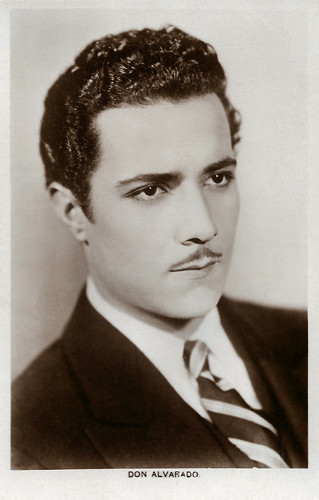
British postcard in the Picturegoer Series, London, no. 348.

British postcard in the Picturegoer Series, London, no. 348b. Photo: Radio.
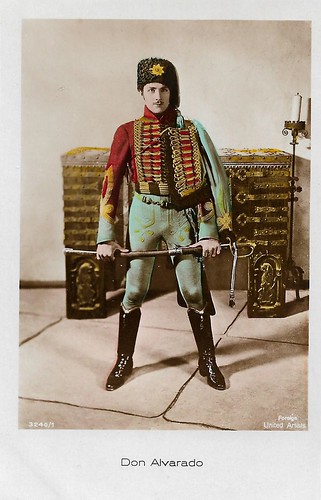
German postcard by Ross Verlag, no. 3240/1, Series Foreign. Photo: United Artists. Don Alvarado in Drums of Love (D.W. Griffith, 1928).
Capitalising on his Latin Lover's looks
Don Alvarado was born José Ray Paige in 1904 in Albuquerque, New Mexico. He first studied agriculture on his father's sheep and cattle ranch. In 1922, at just age 18 he ran away from home and went to Los Angeles, hoping to find acting work in the fledgling silent film industry.
He secured work in a sweet factory before getting into the films working as an extra. While in Los Angeles, he became close friends with the México-born actor, Luis Antonio Dámaso de Alonso, who would later be known as Gilbert Roland. The struggling young actors shared a place for a time.
Alvarado soon met and fell in love with an aspiring actress, sixteen-year-old Ann Boyar, the daughter of Russian Jewish immigrants. They married in 1924. Later that year they had a daughter, actress Joy Page. Don Alvarado got his first uncredited silent film part in the 1924 film, Mademoiselle Midnight (Robert Z. Leonard, 1924) starring Mae Murray.
Jose Paige was given the screen name Don Alvarado by studio chief Jack L. Warner while they purportedly were driving past the Los Angeles street Alvarado. With the studio capitalising on his "Latin Lover" looks, Alvarado was quickly cast in secondary and then leading roles in such films as The Loves of Carmen (Raoul Walsh, 1927) with Dolores del Rio, Drums of Love (D.W. Griffith, 1928) opposite Mary Philbin, and The Scarlet Lady (Alan Crosland, 1928), starring Lya de Putti.
Hans J. Wollstein at AllMovie: "Like the similar Rod La Rocque, Alvarado (born Josè Paige) was perhaps a bit too American; in other words: not perceived as dangerous enough. Best remembered for the two films he did for D.W. Griffith (Drums of Love and The Battle of the Sexes [both 1928]), Alvarado was usually mere fodder for such high-powered female stars as Constance Talmadge, Dolores Del Rio, and Lya De Putti, none of whom found it difficult to steal the limelight from their co-star."
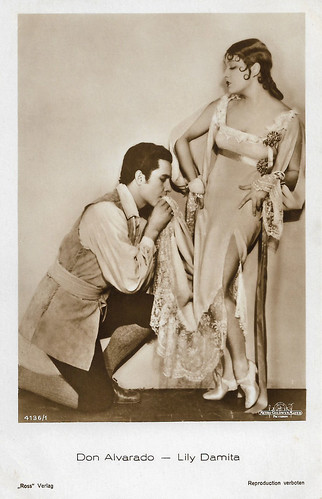
German postcard by Ross Verlag, no. 4136/1, 1929-1930. Photo: Metro Goldwyn Mayer. Don Alvarado and Lily Damita in The Bridge of San Luis Rey (Charles Brabin 1929). The film was shot both as a silent and a sound film.

German postcard by Ross Verlag, no. 4268/1, 1929-1930. Photo: Metro-Goldwyn-Mayer. Lily Damita and Don Alvarado in The Bridge of San Luis Rey (Charles Brabin 1929).

German postcard by Ross Verlag, no. 4268/2, 1929-1930. Photo: Metro Goldwyn Mayer. Don Alvarado and Lily Damita in The Bridge of San Luis Rey (Charles Brabin 1929).
Cast in secondary Spanish character roles
With the advent of talkies, Don Alvarado's starring roles ended. He did, however, manage to work regularly, usually cast in secondary Spanish character roles, such as in the Thornton Wilder adaptation of The Bridge of San Luis Rey (Charles Brabin, 1929) with Lily Damita and the pre-code musical comedy Rio Rita (Luther Reed, 1929) starring Bebe Daniels and John Boles.
After six years of marriage Alvorado's wife, Ann fell in love with the studio head, Jack L. Warner. In 1932, she filed for divorce from Alvarado using what used to be called a "quickie divorce" conveniently available in Mexico. Ann moved in with Warner perhaps as early as September 1933. Warner waited several more years until his parents died before he divorced his wife, Irma, and married Ann in 1936.
Alvarado appeared on stage in 'Dinner At Eight' at the Belasco Theatre in Los Angeles in 1933. In 1939, using the name "Don Page" for screen credit purposes, he began working as an assistant director for Warner Bros. and a few years later as a production manager. In these capacities, he was part of the team that made a number of highly successful films including The Treasure of the Sierra Madre (John Huston, 1948), East of Eden (Elia Kazan, 1955), Rebel Without a Cause (Nicholas Ray, 1955), and his final film work, The Old Man and the Sea (John Sturges, 1958), in which he also appeared in his final, uncredited role as a waiter.
In 1932, Alvarado was briefly engaged to the musical-comedy star Marilyn Miller, but the marriage did not take place. He and his ex-wife Ann remained friends and after a long career as an assistant director, Paige was asked by his former wife if he might like to manage the 80,000-acre Arizona cattle ranch she had purchased with Warner. Page had grown up in cattle country, was an experienced horseman and spoke Spanish. He accepted the job and by all accounts was a respected and much-liked manager.
Don Alvarado died of cancer in 1967, aged 62, in Hollywood, Los Angeles, California and was interred in the Forest Lawn Memorial Park Cemetery in Hollywood Hills. His gravesite has him interred under the name "Joseph Page". For his contributions to the film industry, Alvarado has a star on the Hollywood Walk of Fame at 6504 Hollywood Boulevard.
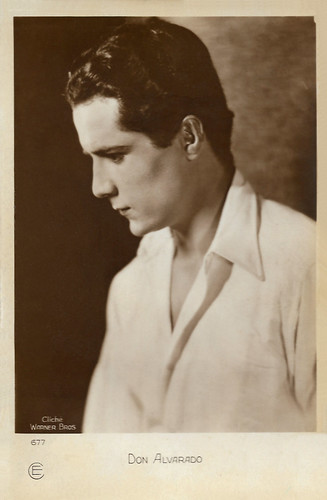
French postcard by Cinémagazine-Edition, no. 677. Photo: Warner Bros.
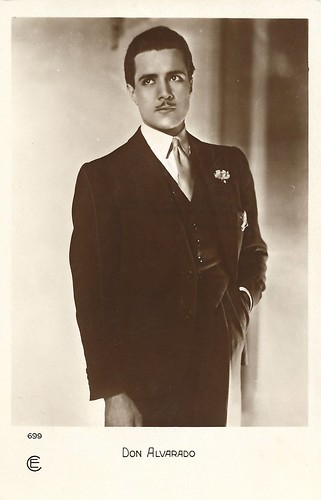
French postcard by Cinémagazine-Edition, no. 699.
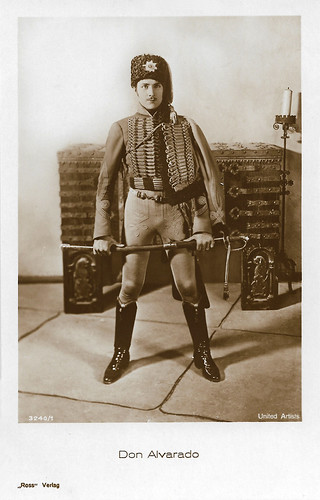
German postcard by Ross Verlag, no. 3240/1, 1928-1929. Photo: United Artists. Don Alvarado in Drums of Love (D.W. Griffith, 1928).
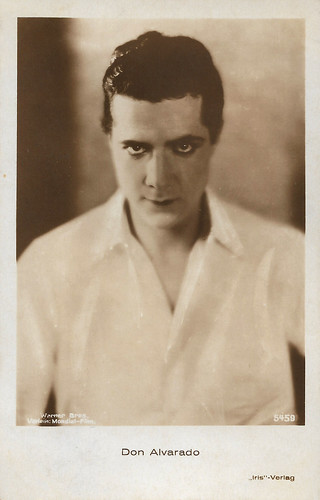
Austrian postcard by Iris Verlag, no. 5459. Photo: Warner Bros / Mondial Film.
Sources: Hans J. Wollstein (AllMovie), Aeri Amadis-Noel (Find a Grave), Gregory Orr (IMDb), Wikipedia and IMDb.
No comments:
Post a Comment